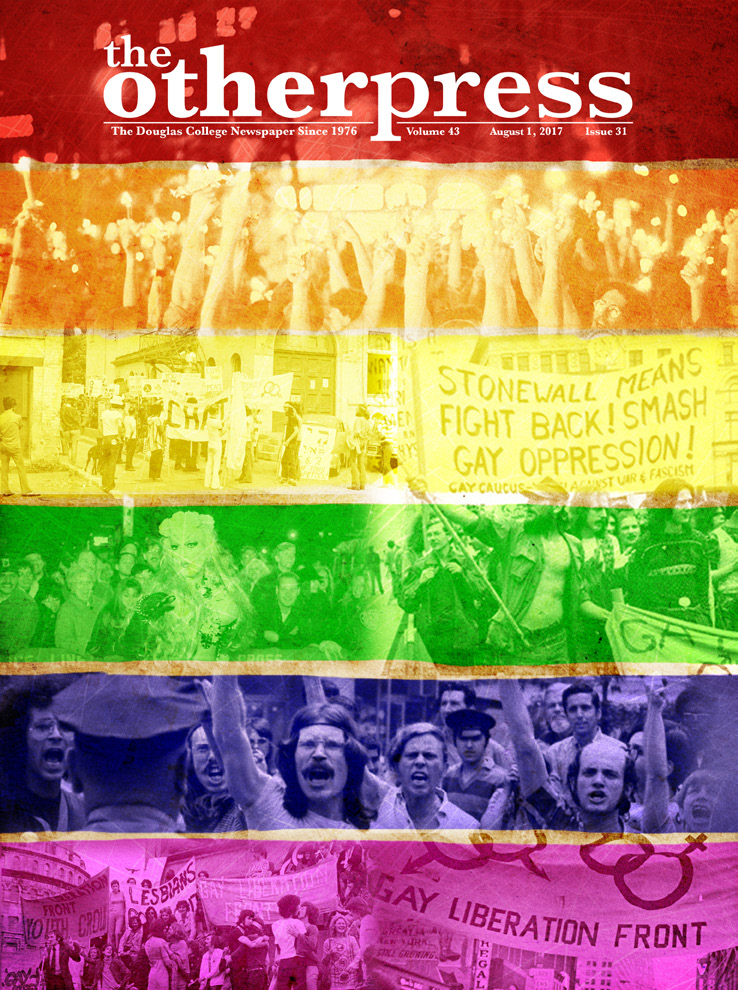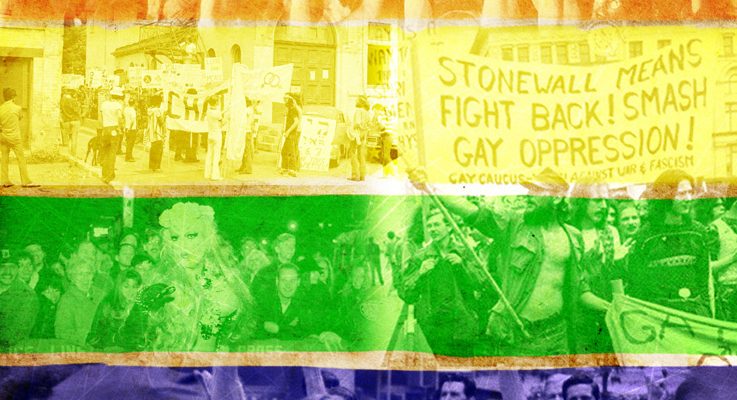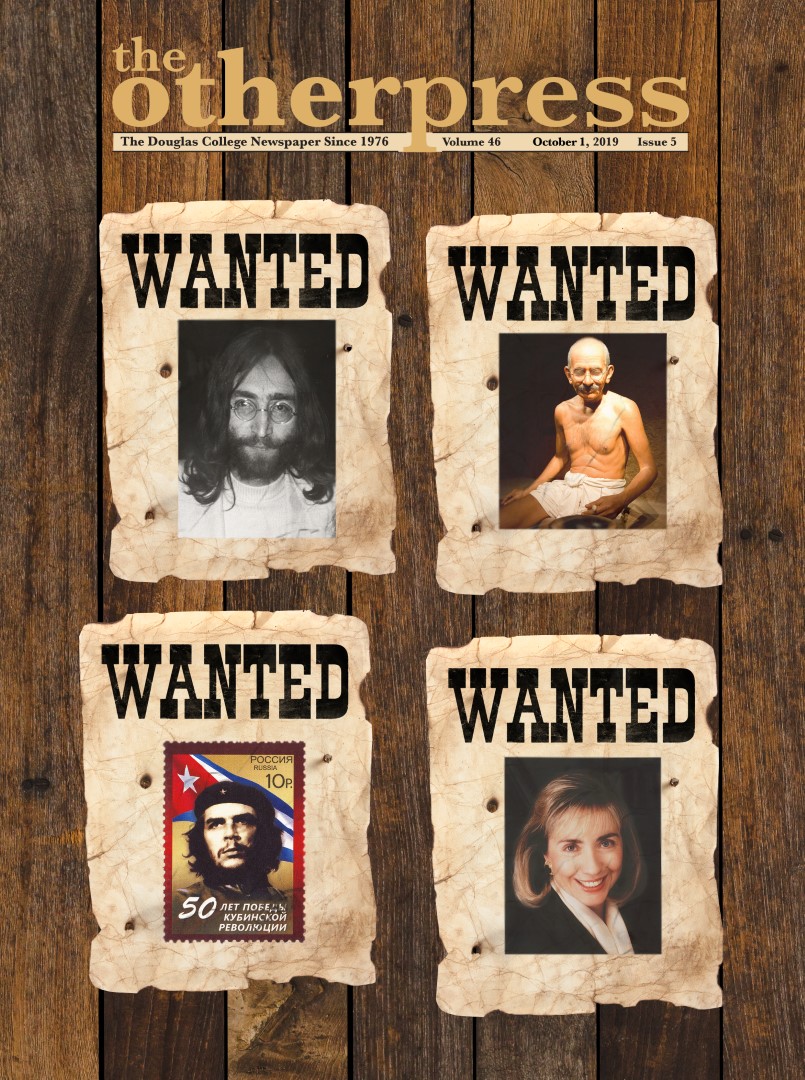
Celebrating the history of gay pride
By Jessica Berget, Staff Writer
On August 6, Vancouver will be commemorating its 39th anniversary of celebrating Pride. Pride in Vancouver began in 1973, when the Gay Alliance Toward Equality hosted their first pride event, a picnic at Ceperley Park. It wasn’t until five years later, in 1978, that the first Vancouver Pride Parade was organized, and since then Vancouver has been famous for having one of the biggest Pride parades in the world. To fully appreciate the celebration of Pride, it is important to understand the history behind it, the events that unfolded, and the people who made it all possible.
The year was 1969. Police raids at gay bars and clubs were a common occurrence, so much so that patrons would typically leave the bar and disperse within a matter of minutes, but in the early hours of morning on June 28, the patrons of the Stonewall Inn were fed up. Fed up with being constantly targeted by police, for being discriminated against, and for being unable to express their individuality, for the first time in history, they fought back.
The Stonewall Inn was a mafia-run gay club and bar on Christopher Street in New York City. The 1960s were not a welcoming time for LGBTQ+ folk, in New York especially. Solicitation of homosexual relations was illegal in the state during this time, and there was a statute in place that allowed police to arrest those who were wearing less than three gender specific articles of clothing. Because of these inequalities, the only place for gay, lesbian and trans folk to socialize freely was at gay bars. Naturally, they flocked to these clubs as a place of refuge. Only in the gay clubs could LGBTQ+ people express themselves, express their sexuality, and socialize with their community without anxiety. However, gay bars at the time were susceptible to raids by police as it was illegal to engage in publicly gay behaviour. It was also legal to deny a suspected homosexual alcohol because, as the New York State Liquor Authority argued, homosexuals gathering was in itself a disorderly act.
The New York City mafia saw a way to capitalize on the needs of the LGBTQ+ folk by opening up their own gay clubs and bars, and in 1966 they purchased, renovated, and reopened the Stonewall Inn, a previously straight bar and restaurant. Stonewall quickly became popular as a safe space for LGBTQ+ folk, drag queens (who were not welcome at any other institutions), and runaways or homeless youth. It was also one of the only gay bars that allowed dancing. Police still raided the club, but since the mafia paid them off to leave the club alone, they would receive a tip if the police were on their way. However, on that early June morning, that tip never came.
Armed with a warrant, police entered the club, roughed up patrons, and arrested about 13 people who were either employees at the club or violators of the gender clothing statute. Female officers would have to take violators to the bathrooms to check if their sex was in accordance with their clothing. Police raids were routine at the time, and patrons would usually leave the club and filter out quickly, but this time the gay community was tired of the constant harassment and fought back. Patrons and neighbouring residents stayed outside of the bar rather than dispersing and yelled at the police. They watched and became increasingly agitated as police arrested and man-handled several patrons.
It wasn’t until one officer hit a woman over the head as he forced her into a paddy wagon—she responded by shouting at onlookers to do something—that the crowd was incited to throw objects at the police. What happened next is still something of a mystery. Some say people started throwing coins at the police, a symbolization of the corruption of the New York state authorities. Some say Marsha P. Johnson, a trans woman of colour and gay rights activist, threw the first bottle. Some say Sylvia Rivera, also a trans woman of colour and activist, threw the first brick. As Kelendria Nation, a trans woman of colour educator and activist said, “The Stonewall riots are a bit of a folklore; no one knows what really happened or who threw the first bottle, but we do know that trans women were at the forefront.”
Within minutes, a riot erupted between the patrons of the Stonewall Inn and the NYPD. As police attempted to diffuse the crowd, the protest spread to neighbouring streets. Order was not restored until NYC riot police were called in. The crowd was eventually dispersed, but riots and protests continued on with as much as one thousand people. Six days of protests and violent demonstrations against the New York law enforcement followed the riot, becoming the first major protest for the equal rights of LGBTQ+ folk and serving as a catalyst of the gay rights movement.
Gay rights activists began plotting the first ever pride parade on June 28, 1970; exactly one year after the Stonewall Riots. They marched over 51 blocks, and at their destination they then held a “gay-in.” News of this picked up, Pride marches began happening all over America, and soon it became a yearly tradition. The birth of gay pride. The Stonewall Inn is now a monument, and Christopher Park hosts a national monument with statues commemorating the people who paved the way for gay liberation. However, even though trans icons like Marsha P. Johnson and Sylvia Rivera were major icons in the riots and in the gay rights liberation, they are not represented by these statues.
Marsha P. Johnson was a trans icon, drag queen, activist and revolutionary figure in the liberation of LGBTQ people. In 1970, she joined the Gay Liberation Front and met fellow trans activist Sylvia Rivera. The two quickly became good friends and created the Street Transvestite Action Revolutionaries (STAR), a gender nonconforming and transgender activist organization. They also founded the STAR house, the first housing organization that supplied clothes, food, shelter, and advice to homeless or troubled trans youth. They fought for their entire lives for the inclusion of drag queens and trans people in the pride movement until their unfortunate deaths, which were deemed suicides by the police. Johnson did have a history of mental illness, but close friends of hers have stated that she was never suicidal. Considering the violence that took place against trans people, especially trans people of colour in the past and even in the present (GLAAD claims that 15 transgender women of colour have been killed in 2017 alone), Johnson’s death as a homicide is plausible.
We hold our Pride events today because of the brave LGBTQ+ people who had nothing else to lose and fought hard for LGBTQ+ equality and representation. We have Pride not only to commemorate those people, but also to demand visibility, equality, and solidarity for all gay, lesbian, and transgender people around the world. You might not feel a connection to those who protested in New York in 1969, but it is only because of them that we are able to celebrate Pride at all.
It may seem like we have come a long way since the Stonewall riots, but we aren’t quite finished fighting yet.


